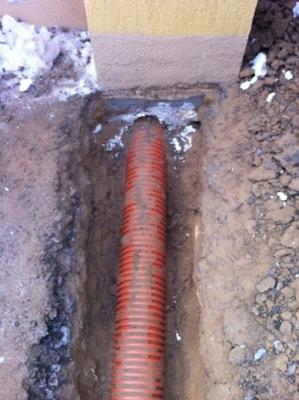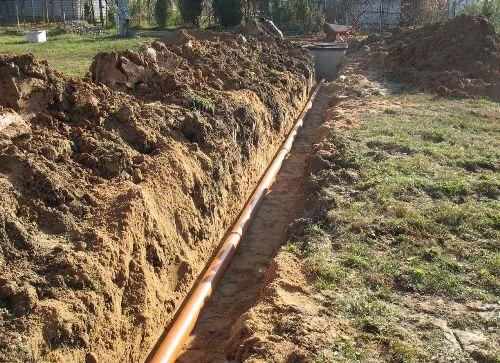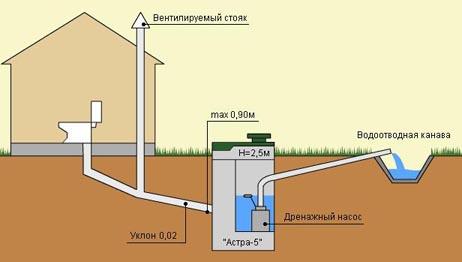To reduce sewer construction costs, the depth of the sewer pipe must be calculated correctly. With an increase in the depth of the pipeline in the ground, as a rule, its installation also becomes more expensive. In addition, this affects the possibility of efficient operation of the sewer system. Therefore, taking into account technical standards and climatic features of the area, it is necessary to choose the minimum possible depth.
Factors affecting the depth of sewerage
The calculation of the depth of laying sewer pipes takes into account the following parameters:
- climate mark, which displays the power of annual soil freezing, this indicator is regulated by the normative act SNiP 2.01.01.82;
- technical properties of materials used in construction;
- specific features of the pipeline;
- the depth at which the sewer system is connected to a collector or septic tank;
- terrain;
- the maximum dynamic load acting on the sewer system (if the laying is carried out under the road).
The depth of soil freezing is a fundamental factor

The design of sewer pipelines begins with determining the depth of freezing of the soil into which the sewer will be laid. The maximum depth, measured in standard units of measurement, below which moisture in the soil does not crystallize, is considered the mark of soil freezing. The depth of the sewer pipes depends on it.
Below the freezing mark, the soil does not freeze, its volume does not increase and, therefore, there is no effect on the pipeline laid in it. The depth of freezing for each region can be found in the collection of standards "Construction climatology", in the section of cartographic materials.

If for some reason it is not possible to access the collection, the local metrological service will help. Employees of the organization will tell you the value of the indicator, which was revealed as a result of many years of studying the properties of the soil. For example, studies have shown that in central Russia, the freezing depth is on average 1.4 m, in the North region - 1.8÷2.4 m, and on the Black Sea coast - 0.8 m.
A feature of the construction of sewerage is that, unlike water supply networks, the depth of sewer pipes is calculated by subtracting a certain distance from the soil freezing depth indicator, since sewer pipes transport effluents of positive temperature. The value by which the laying depth is reduced depends on the diameter of the sewer pipes:
- with a diameter of up to 0.5 m, it is 0.3 m. For example, in order to sewer into a house using pipes with a diameter of 0.4 m, in an area with a soil freezing depth of 1.6 m, it is necessary to lay pipes in the soil to a depth of 1, 30 m (1.60 - 0.30 = 1.30 m);
- with a larger diameter of pipes - 0.5 m. For example, to improve the same house, but using pipes with a diameter of 0.6 m, the required depth of laying sewer pipes will be 1.10 m (1.60 - 0.50 \u003d 1, 10 m).
Having completed the calculation of the sewer pipes, they begin to dig trenches into which the pipeline is then laid. It is possible to reduce earthwork costs by making trenches as narrow as possible. Reducing the depth of the pipes is prohibited.
Relief features
The depth of laying sewer pipes will also greatly depend on the features of the terrain. When constructing a sewer on a relatively flat area, the depth will be the same along the entire length of the pipeline.

But if the landscape has pronounced differences in height, the depth of the sewer pipe is calculated from the lowest point of the landscape on the site. In this case, the statement that the higher the pipes are laid in the ground, the lower the cost of materials and earthworks is not true, because the result will be a complex undulating construction of the main. For uneven terrain, it is advisable to build a direct sewer pipeline to a constant depth with a certain slope.
Pro tip: When the sewer system is laid in places where vehicles or people move, it is necessary to take into account the dynamic load on the polymer pipeline. In such areas, laying should be carried out in a closed way or reinforced polymer corrugated pipes should be used.
Technical characteristics of sewer pipes
Ceramic and metal sewer pipes have been replaced by their modern counterparts - plastic pipes. The advantages of polymer products are enough:
- acceptable price;
- durability;
- ease of transportation to the installation site;
- ease of installation, etc.

However, there is also a significant drawback: the depth of laying polymer pipes in the soil is limited. Therefore, before purchasing the material, carefully read the technical characteristics of the products contained in the manufacturer's instructions.
When constructing a sewer system from polymer pipes, they are mainly guided by the experience of building and operating identical communications in a particular region. And in the absence of reliable data, the calculation of the strength of polymer products is carried out according to SP 40-120-2000, which regulates the principles for the design and installation of plastic sewer pipelines.
Pro tip: When reading information about polymer sewer pipes, pay special attention to the laying depth indicator. It must necessarily meet all the conditions of the sewerage project on your site. Otherwise, the pipeline may not withstand the pressure of the soil and fail, which will lead to the need to dismantle the sewer and build a new one.
Additional aspects

The calculated depth of laying sewer pipes is an approximate value. It is subject to mandatory adjustment, taking into account the length of the pipeline, the landscape of the site and the design features of the sewerage system.
Private houses are most often supplied with gravity sewers. In such a system, when laying, it is necessary to observe the slope of the pipeline towards the treatment plant by 0.02 m per linear meter of pipes (for example, with a sewer pipeline length of 20 m, the depth of the point at which the pipes are connected to the septic tank will be 0.40 m more) .
If a pump is installed in the sewer network that performs the forced transportation of effluents through the pipeline, a slope is not needed. The operation of the pump will not allow wastewater to stagnate and freeze at low temperatures, forming an ice plug. However, a pressure (forced) sewer system is less popular in the construction of private houses.
A qualified calculation of the depth of the sewer pipeline ensures its long and efficient operation, the absence of breakdowns and other problems. In addition, knowing this indicator, you can choose the best option for laying pipes and thus reduce costs in acceptable ways.


















